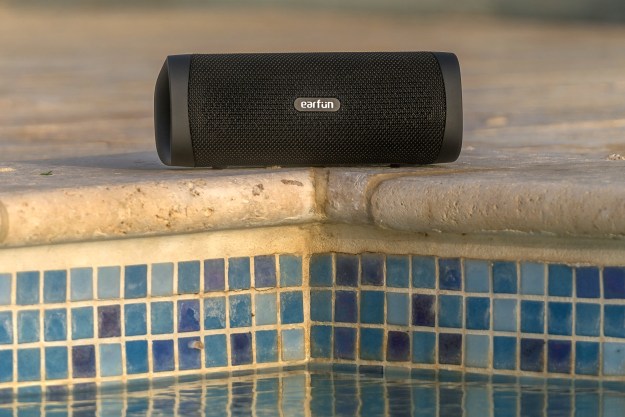
- Rugged, durable build
- Excellent sound quality
- Easy setup
- Stereo and multi-speaker pairing
- Good battery life
- Affordable price
- No app support
- Video mode weakens Bluetooth signal
- Not a flashy design
It’s easy enough to find a wireless Bluetooth speaker small enough to fit in your backpack or carry-on when taking it with you, but what’s worth spending money on to serenade your ears? The bevy of options makes good value all the more appealing when you find it, and that’s the EarFun UBoom L in a nutshell.
At $80, you’re not breaking the bank relative to other speakers, and you get great sound for every buck you spend on it. We took this speaker everywhere to find out how much each dollar stretches when the music plays.
What’s in the box
EarFun didn’t pack much in the box for the UBoom L. Apart from the speaker itself, you only get a USB-C charging cable and user manual. While the speaker does have a 3.5mm Aux-In jack, you don’t get a cable for it in the box. There’s also no wall charger for USB-A-to-USB-C cable.
Design

When first looking at the UBoom L, there isn’t anything all that remarkable about it. It looks like any other Bluetooth speaker, complete with a fabric skin, and rubberized bumpers on either end protecting the two passive radiators. This is purely meant to be a lateral speaker, meaning you lay it down flat. While you could stand it upright, it’s not on a secure footing, and it’s pretty clear that wasn’t the original intention.
If size matters, the speaker measures 3.07 x 8.26 x 2.83 inches, with the top sloping a little to make the front look more prominent and give it a slightly upward-facing orientation. It’s easy enough to carry around at 1.43 pounds, and if you happen to be clumsy with it, you will probably still hear it playing. The UBoom L is waterproof, able to withstand saltwater — plus, it floats, so an accidental dip won’t see it drop like a stone to the bottom.
EarFun doesn’t specify a shockproof rating beyond its IP67 protection for water and dust resistance, but there is some durability here. I wouldn’t describe it as rugged to the point you can abuse it, but an unfortunate tumble to the ground shouldn’t stop it from functioning. It fits in perfectly well outdoors, be it at the beach, pool, hot tub — basically anywhere you can put your feet up to relax and enjoy some tunes.
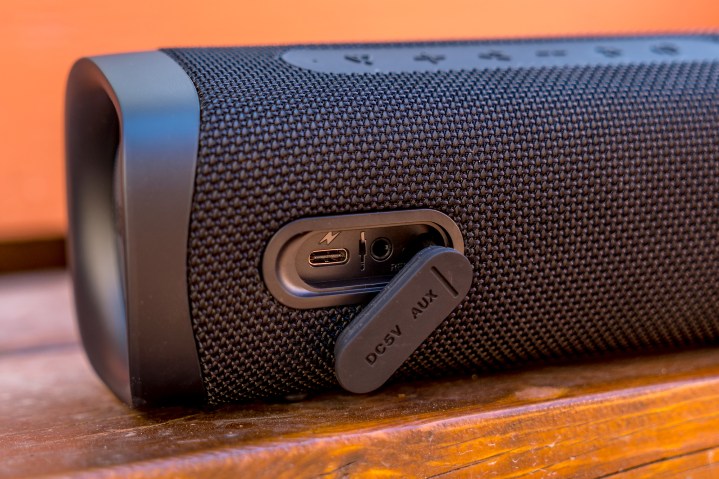
A rubberized cover protects the USB-C and 3.5mm Aux-In ports in the back, keeping water out, though I grew to dislike having to open it each time because the flap is hard to grip and pry open. Thankfully, it’s not something you’re likely to need all that often, at least until you have to charge it.
There aren’t any fancy proprietary technologies at work as far as how the UBoom L pumps out sound, so this is more about how EarFun engineered the components inside. Two 55mm drivers and a Class D amp pump out 14 watts per channel, with the aforementioned passive radiators pushing out bass at both ends.
Setup and app controls
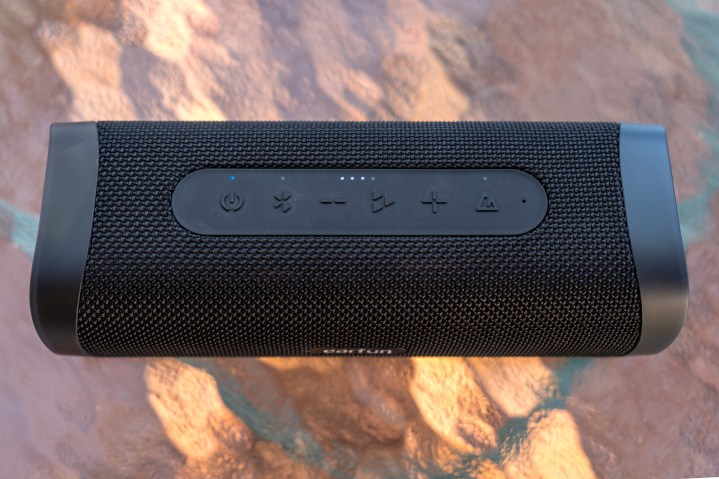
Pairing the UBoom L is easy enough to do by simply going to the Bluetooth menu on your device and going from there. EarFun doesn’t support the speaker with an app, so you don’t have tools to tinker with. But there are a couple of important points that stand out.
The speaker does have two playback modes: indoor and outdoor. Press the mode button on the far right to toggle between them, with the white LED indicating when outdoor mode is on. The other is stereo pairing for left and right channels. Here, too, there are two ways to go about it. You can opt to play them as separate left and right channels, or in “party mode,” which basically has the two speakers play the same content without the stereo pairing.
The rest of the control layout is pretty straightforward. You have play/pause, flanked by volume up and down, along with Bluetooth and the power button. One extra EarFun threw in is a video mode tied to the Bluetooth button. Pressing it twice turns it on (indicated by a white LED), thus reducing latency from the standard 250ms to 150ms. That’s fine for watching a show or movie, though I found it a bit sluggish for gaming, so probably not ideal if that’s something you had in mind. The video mode does shorten the 45-foot Bluetooth range, though I can’t quantify an exact number. Nor does EarFun, other than to suggest always leaving that mode off when you’re listening to music, podcasts, or audiobooks for the sake of a stable connection, especially if you’re moving around with your phone.
Sound quality

It would be unfair to expect audiophile playback with a speaker like the UBoom L, but the results are impressive, both in clarity and volume. This speaker isn’t so much about lowering the boom, given its bass response is still resonant and thick enough to appreciate, even more so when it comes with good balance throughout the spectrum. Not surprisingly, the mids get pushed back, yet they’re still audible enough to complement the solid highs.
I listened to a wide range of genres, both indoors and outdoors, as I took the speaker with me on a recent vacation. Its outdoor mode is kind of like a “loud” setting you see in other speakers, where the bass and treble boost up with louder volume output to sound bigger in larger spaces. Sure enough, I often chose that setting when I wanted to get a bit louder, whereas normal listening indoors didn’t necessitate cranking things up.
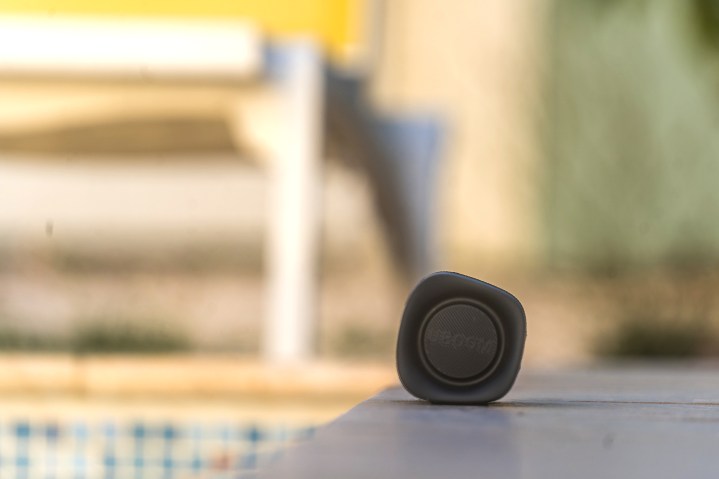
For instance: There was no reason to do it while listening to a podcast or audiobook. Spoken word content just doesn’t need the same range as music does, so toggling between the two modes made more sense as I went along. There were times I would use the outdoor mode while inside to hear the deeper bass, while I used the indoor mode outside while lounging with a cigar listening to a podcast or audiobook. For a speaker devoid of much customization, it felt pretty satisfying to at least be able to do something. When I did play it loud, I was impressed to hear distortion hold off until it got really high. The outdoor mode is tuned to rattle the bass and add a little sibilance to the highs at the highest levels, but I found the indoor mode somewhat mitigated that. Again, making up for an overall lack of customization.
Watching video with it via Aux-In on a laptop was great for removing all latency, though the video mode was fine when doing it wirelessly. The only catch is the Bluetooth connection is more susceptible to obstacles that might get in the way. In close quarters, you’re fine, but wander or keep the speaker too far away, and the odd drop-off or hiccup will happen.
As a speakerphone, the UBoom L also proved very capable. Calls were clear, and my voice came through well via the onboard microphone. It won’t match more expensive speakers, like the Sony SRS-XE200, but it is better at capturing voices more spatially. Rather than facing it head-on, you can be on either side because the mic is on top with the button array.
Battery life
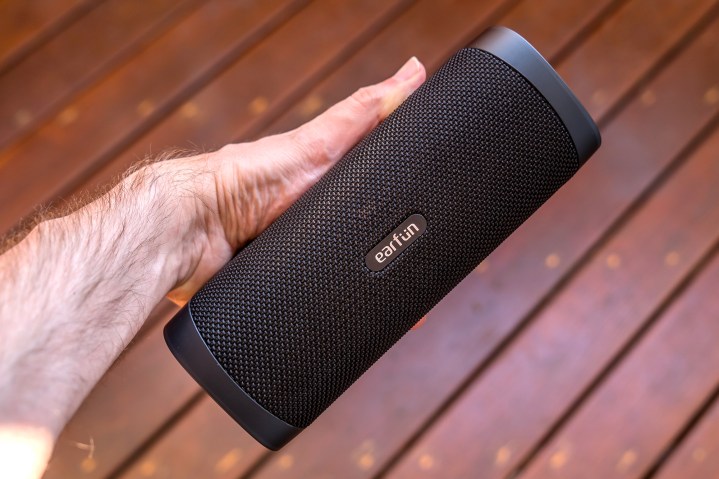
EarFun says the UBoom L can last up to 16 hours per charge, and that’s largely true if you keep the volume at the default level with indoor mode on. Raising the volume and routinely sticking to outdoor mode changes that. But even at north of 10 hours, it’s hard not to like the results. Go full blast and you kill the battery in a fraction of the time, though I never sustained it at that level long enough to find out by exactly how much.
There’s no fast charging here. Instead, you plug in and wait for those four LEDs up top to stop flashing. It does take a good two hours to fully top up, and of course, you can always play and charge at the same time.
Our take
EarFun kept things simple with the UBoom L, focusing on what needs to work well. Great, balanced sound, coupled with ease of use and superb durability enable it to fit in just about everywhere. Not all Bluetooth speakers at this price can stake that kind of claim, so there’s real value here, if you want it.
Is there a better alternative?
Despite the great price — and the likelihood of discounts along the way — the UBoom L does have competition. The Ultimate Ears Wonderboom 2 has the same level of durability, and while its battery life won’t stretch quite as far, there is a useful strap to keep it close to you. If you like the idea of customizing things via an app, you might want to look at the Anker Soundcore Flare 2, which lets you do just that. It won’t get quite as loud, but the app’s EQ does let you play around a lot with the overall tuning.
If your budget allows, you may be able to snag the JBL Flip 5 for about $100 or less if you come across a good deal. It’s not JBL’s latest, but it can still rock, and take some punishment while doing it. No app support, yet you do get a smaller footprint for even easier portability.
How long will it last?
EarFun clearly aimed to build the UBoom L to last a long time with its tougher build quality. That it floats also means you’re less likely to lose it in the water, though without a lanyard to strap on, you do need to be careful. EarFun’s 18-month warranty doesn’t cover damage from water or from the device falling. It primarily focuses on functional issues.
Should you buy it?
Yes. You don’t get anything flashy with the UBoom L, but EarFun did right by its speaker, engineering it to perform better than its $80 price tag indicates.




